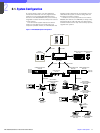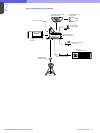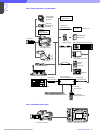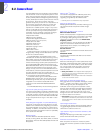
1
Chapter 1 Introduction 10HDC-900/950/930 Series Product Information Manual
(MSU) parameter settings can be transferred to other
cameras in a system for perfect picture matching.
Ergonomic Body Design
For over two decades, Sony has been designing and
manufacturing broadcast video cameras and
camcorders. In creating these designs, great
importance has always been given to achieving
control layouts based on the practical, operational
requirements of the user. The control layout of the
HDC-900 therefore naturally follows that of other HDC
and BVP Series cameras. For example, the V/F
adjustment and controls for the intercom system, V/F
return selection, lens filter selection, etc. are all located
in similar positions to previous models, so that
operators with experience of Sony cameras can
operate this new model intuitively.
The HDC-950/930 portable model features a body
that is so compact and lightweight that it opens up new
and exciting possibilities in location camera work.
Newly developed ADSP LSIs drastically reduces its
power consumption, which helps contribute to the
stable operation of the entire system. This design with
a low optical axis and superb weight distribution
means that the camera can be carried comfortably on
the shoulder without causing fatigue. Tripod operation
is just as easy, and the HDC-950/930 has all its
controls and connectors located in similar positions to
those on Sony BVP cameras. Even with a viewfinder,
microphone and a standard ENG lens, the total weight
of the HDC-950/930 is only around 7 kg (about 16
pounds).
Optical Filter Wheels
Independent ND and CC optical filters are provided on
both the HDC-900 and HDC-950/930. The filter drives
provided for both 900 and 950/930 are exactly the
same, so that common operation is enabled between
the hard camera and the portable type when the filter
settings are adjusted remotely on a RCP, MSU or RM-
B750/B150 Remote Control Unit.
Electronic Shutter
The electronically operated shutter provides speeds of
1/100, 1/250, 1/500/, 1/1,000, and 1/2,000 of a second
(1080/60i mode).
Clear Scan and ECS (Extended Clear Scan)
Sony’s Clear Scan and ECS* functions eliminate
banding effects when shooting monitor displays by
allowing the shutter speed to be adjusted so that it
exactly matches the various scanning frequencies that
are in use. The clear scan shutter speed range is 60.1
to 4300 Hz (1080/60i mode). The ECS function is
especially effective under the frequency of 60 Hz or 50
Hz.
* The ECS function is available with the HDC-900 and HDC-
950
Super EVS
Super EVS (Enhanced Vertical-definition System)
raises vertical picture resolution, while minimizing line
flicker*. It is ideal for shooting of a stationary subject or
still images - the method used for the “Claymation”
process, for instance.
* The Super EVS functions when operated at Interlace mode.
Standard 2/3-inch type Lens Mount
Either an HD lens or a standard definition 2/3-inch type
format lens can be mounted. This allows standard
lenses that are in everyday use with Sony cameras and
camcorders to be used with the HDC-900 and HDC-
950/930.
Memory Stick
™
Media Card
Sony Memory Stick
™
media card technology
provides a new function on both the HDC-900 and
HDC-950/930. Camera operators can store their
personal preferences for a number of camera set-up
parameters and V/F indicators in a personal Memory
Stick media card. Whenever one of these memory
devices is inserted into its slot on a HDC-900/950/930
camera, the operators particular settings are instantly
recalled. All the data stored in one or more Memory
Stickmedia cards also can be registered and stored in
a standard PC, so that each set of preferences can
then be used to initialize individual or groups of
cameras.
Multi Matrix
This function enables a particular color in a scene to be
selected and its hue and saturation changed.
Adaptive Highlight Control (Auto Knee mode)
The Sony ADSP system intelligently monitors the
brightness of all areas of the picture and automatically
adapts the knee point/slope for optimum reproduction
at that particular scene location within the picture. A
typical example is shooting an interior scene which
includes a sunlit exterior seen through a window.
Three-channel Skin Tone Detail Correction
The Skin Tone Detail Correction controls the detail
level of those objects in a scene with specific color
tones. The HDC-900/950/930 allows detail to be set
independently for each of three separate color ranges.
These colors are not limited to skin tones, but can be
set for any color. Detail may be increased or
decreased relative to the normal level.
Knee Saturation Function
This function works similar to - Sony’s TruEye™
processor which is one of the most innovative features
that Sony ADSP allows. This function - makes it
possible to reproduce very natural colors of high
contrast scene content. When knee correction is
individually applied to the RGB channels, it can lead to
color distortion in highlight areas, for example skin
tones can tend to look yellow. Knee Saturation
processing automatically retains accurate color in
these highlight areas to maintain the saturation in those
picture areas compressed by the Knee function.
Low-key Saturation
The Knee Saturation function is also effective for low-
key pictures, maintaining saturation to give color
reproduction characteristics.
Selectable Gamma and Initial Gain
Several Pre-set Gamma curves and Initial Gain
settings are provided to emulate standardized video
gamma transfer characteristics. These gamma tables
are always accessible and interchangeable via the
camera set-up menu.
Variable Black Gamma Range
The Variable Black Gamma Range function helps to
precisely control shadow areas. It can help to bring out
details from the dark areas of the picture without
affecting mid-tones and keeping the absolute black
level unchanged. 12-bit A/D and the low noise CCD
have extended the prowess of this important
subjective picture control.
Black Stretch
Limits the Black Gamma function to picture luminance.


















